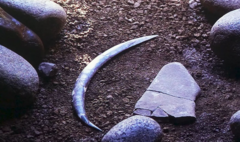The article text:
Archaeologists have made a groundbreaking discovery in Poland, uncovering what is believed to be the world’s oldest boomerang, which they have dated to approximately 40,000 years old. Initially found in 1985 in the Oblazowa Cave, this extraordinary tool predates previous assumptions about its age. The latest research suggests that this ancient implement was carved from mammoth ivory and exhibits remarkable precision, indicating a sophisticated understanding of tool-making by early Homo sapiens.
Through advanced radiocarbon dating techniques applied to human and animal bones unearthed at the site, experts have revised the boomerang's age from an earlier estimate of 30,000 years to a range of 39,000 to 42,000 years. Dr. Sahra Talamo, a leading researcher from the University of Bologna, emphasized the significance of this finding, noting that it offers "remarkable insight" into the capabilities of early humans who crafted such an expertly designed hunting tool during a time long before recorded history.
The boomerang itself, curved and roughly the size of a baseball bat, is exceptionally well-preserved, featuring distinct score marks that suggest it was meticulously polished and possibly tailored for a right-handed user. Despite its aerodynamic design, researchers clarify that this particular boomerang would not have returned to the thrower, which juxtaposes the typical association of boomerangs with Australian Aboriginal culture.
Historically, the notion of boomerangs has been closely tied to Australia, with the oldest known variant from the continent dating back just 10,500 years to a wooden construction. However, the evidence presents a more expansive narrative of boomerang use across multiple continents, including a wooden boomerang from Jutland in Northern Europe dating back 7,000 years and finds from The Netherlands dating back 2,000 years which did return.
This critical research, led by an international team from Poland, Italy, Germany, France, Switzerland, and the UK, has been published in the journal PLOS One, shedding light on the evolutionary and cultural heritage of tool use in early human societies.
Archaeologists have made a groundbreaking discovery in Poland, uncovering what is believed to be the world’s oldest boomerang, which they have dated to approximately 40,000 years old. Initially found in 1985 in the Oblazowa Cave, this extraordinary tool predates previous assumptions about its age. The latest research suggests that this ancient implement was carved from mammoth ivory and exhibits remarkable precision, indicating a sophisticated understanding of tool-making by early Homo sapiens.
Through advanced radiocarbon dating techniques applied to human and animal bones unearthed at the site, experts have revised the boomerang's age from an earlier estimate of 30,000 years to a range of 39,000 to 42,000 years. Dr. Sahra Talamo, a leading researcher from the University of Bologna, emphasized the significance of this finding, noting that it offers "remarkable insight" into the capabilities of early humans who crafted such an expertly designed hunting tool during a time long before recorded history.
The boomerang itself, curved and roughly the size of a baseball bat, is exceptionally well-preserved, featuring distinct score marks that suggest it was meticulously polished and possibly tailored for a right-handed user. Despite its aerodynamic design, researchers clarify that this particular boomerang would not have returned to the thrower, which juxtaposes the typical association of boomerangs with Australian Aboriginal culture.
Historically, the notion of boomerangs has been closely tied to Australia, with the oldest known variant from the continent dating back just 10,500 years to a wooden construction. However, the evidence presents a more expansive narrative of boomerang use across multiple continents, including a wooden boomerang from Jutland in Northern Europe dating back 7,000 years and finds from The Netherlands dating back 2,000 years which did return.
This critical research, led by an international team from Poland, Italy, Germany, France, Switzerland, and the UK, has been published in the journal PLOS One, shedding light on the evolutionary and cultural heritage of tool use in early human societies.




















